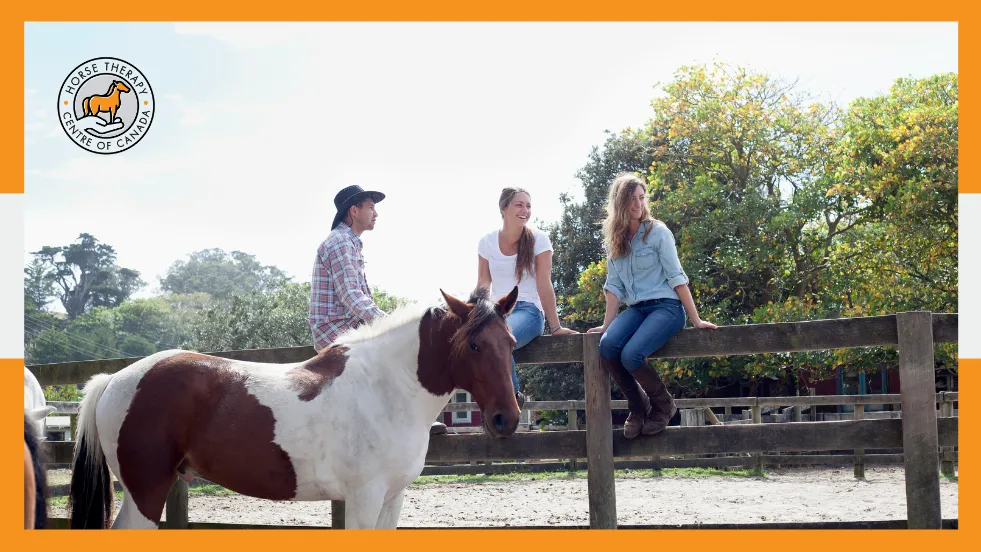
Unleashing Leadership Potential Through Equine-Assisted Learning
The Unique Power of Horses in Leadership Development
What if the key to unlocking your leadership potential lies in the unlikeliest of places, a field with a horse as your guide? Imagine standing face-to-face with a horse, using no words, yet finding new clarity, confidence, and decision-making skills. This is the power of equine therapy learning.
In recent years, horse-assisted leadership development has become an innovative approach to building leadership skills, helping individuals to step up, take charge, and grow in their roles, whether in business, personal life, or within a team. Horses are powerful animals, but they are also keen observers, responding to body language, emotions, and subtle shifts in energy. These characteristics provide a unique setting for self-discovery, growth, and the enhancement of essential leadership qualities such as emotional intelligence, confidence, and decision-making.
In this blog, we will explore how equine therapy learning can help you harness your leadership potential, foster essential leadership traits, and ultimately become a more impactful leader. We’ll also dive into the science behind horse-assisted learning, how it works, and why it has gained such popularity in leadership development programs.

What Is Equine-Assisted Learning? Understanding the Basics
The Concept of Equine-Assisted Learning
Equine-assisted learning (EAL) is a therapeutic method that involves interacting with horses to foster personal growth, self-awareness, and emotional development. Unlike traditional forms of therapy, EAL focuses on experiential learning, allowing participants to gain insights through hands-on activities with horses rather than through talk therapy.
This method works because horses are highly sensitive creatures. They are non-judgmental and can pick up on human emotions, physical states, and energy levels. This unique ability makes them powerful tools in leadership development. In horse-assisted leadership development, horses act as mirrors to human behavior, reflecting how an individual’s internal state (emotions, mindset, confidence) influences their actions and decisions.
The Role of Horses in Leadership Development
Horses don’t rely on verbal communication but instead respond to subtle cues such as body language, tone, and energy to interpret intentions. This provides a unique opportunity for individuals to understand how their presence and emotions influence those around them. Unlike human interactions, where words can mask true feelings, horses react authentically to a person’s leadership style, making them powerful teachers in leadership development.
Through equine-assisted learning, individuals refine critical leadership skills in a real-time, immersive setting. The experiential nature of working with horses fosters self-awareness, adaptability, and confidence, traits that are essential for effective leadership.
The Key Components of Horse-Assisted Leadership Development
Building Confidence Through Equine-Assisted Learning
Confidence is essential for leadership. Without confidence, leaders may struggle to make decisions, take charge, or inspire trust in their team. In equine therapy learning, individuals can build their confidence by learning how to approach, engage, and lead horses, an activity that requires assertiveness, clarity, and calm energy.
Through this process, participants learn how to project their inner confidence outwardly, allowing them to gain the trust of both horses and people. The non-judgmental nature of horses helps reduce fear and anxiety, encouraging leaders to trust themselves and their abilities. As horses respond positively to confident behavior, individuals internalize the importance of maintaining a strong, steady presence.
Emotional Intelligence and Self-Awareness
Emotional intelligence is one of the most important traits of effective leaders. It involves being able to recognize and regulate your own emotions, as well as understand and influence the emotions of others. In horse-assisted leadership development, horses offer immediate, honest feedback based on their emotional sensitivity.
When a leader enters a ring with a horse, the horse’s reaction often mirrors the leader’s emotional state. If the leader is anxious or distracted, the horse may become uneasy or uncooperative. However, if the leader is calm, centered, and clear, the horse responds accordingly. This immediate feedback helps participants develop emotional regulation skills and heightens their awareness of how their emotional states influence their leadership.
This aspect of equine therapy learning encourages participants to assess and manage their emotions more effectively, ultimately leading to better leadership outcomes in real-life situations.
Decision-Making and Problem-Solving
Making quick, effective decisions is a hallmark of strong leadership. Horses present an opportunity for individuals to hone their decision-making abilities in real time. In equine-assisted learning, participants are often asked to guide a horse through specific tasks, such as leading the animal through an obstacle course or maneuvering in a specific direction.
The horse's response to the leader’s actions provides immediate feedback, allowing individuals to assess whether their decisions were effective. If the horse doesn’t follow the leader’s lead, the individual must reconsider their approach, learning valuable lessons in problem-solving and adaptability. This real-time feedback helps individuals make better decisions in high-pressure environments, a crucial skill for leadership.
Building Confidence
In equine-assisted learning, confidence is a cornerstone of effective leadership. Horses, as highly intuitive animals, respond primarily to body language, posture, and energy rather than verbal communication. When a participant is uncertain or hesitant, the horse can sense this and may resist following, mirroring the lack of confidence in the leader’s actions. However, when the individual projects assertiveness through steady posture, clear direction, and a calm presence, the horse responds positively, highlighting the power of confident leadership.
This process helps participants understand that leadership is not just about making decisions but about exuding certainty and control. By practicing leadership with horses, individuals learn how to build and project confidence in real-time, gaining a deeper awareness of how their presence and energy impact those around them. This hands-on experience in the presence of such a perceptive animal provides immediate feedback and allows leaders to refine their ability to lead with assuredness.
By engaging in horse-assisted leadership development, individuals learn to adapt their leadership style, regulate their emotions, and create an environment of trust and respect, essential qualities for both personal and professional success.

The Benefits of Equine-Assisted Learning for Leadership
Building Trust and Rapport
One of the most important aspects of leadership is the ability to build trust with others. Horses, being highly intuitive and non-judgmental, provide a unique opportunity for individuals to practice building trust and rapport. In horse-assisted leadership development, the process of working with horses requires individuals to build a relationship based on mutual respect and understanding.
As individuals learn to lead horses through tasks, they gain a deeper understanding of how their behavior affects others. Horses teach participants the value of patience, consistency, and clear communication, skills that are essential for building trust and rapport with a team.
Developing Adaptability and Resilience
In leadership, the ability to adapt to new situations and bounce back from setbacks is crucial. Equine therapy learning encourages participants to be flexible in their approach to leadership. Horses don’t always respond the way we expect them to, and this unpredictability can be a valuable lesson in resilience. By learning to adapt to the horse’s behavior and respond with patience and persistence, individuals strengthen their capacity for overcoming challenges and leading with resilience.
Resilience is a skill that can be learned over time, and horses are a great way to develop this trait. If the horse doesn’t respond as anticipated, the leader must stay calm and adaptable, reassessing their approach. This ability to recalibrate when faced with a challenge can improve leadership in high-stress, rapidly changing environments.
The Science of Equine-Assisted Leadership Development
Why Do Horses Make Great Leadership Teachers?
Horses are instinctively attuned to their environment, making them highly effective partners in equine therapy learning. As prey animals, they rely on non-verbal communication to assess safety and trustworthiness. They are incredibly sensitive to body language, posture, and emotional energy, allowing them to detect and respond to human emotions with authentic, immediate feedback.
This natural sensitivity enables horses to act as mirrors, reflecting an individual's internal state, confidence, and emotional balance. Through equine therapy learning, participants gain valuable self-awareness, recognizing how their thoughts, emotions, and behaviors influence those around them. This feedback loop fosters emotional intelligence, helping individuals refine their ability to lead with clarity, confidence, and authenticity.
Additionally, horses live entirely in the present moment, requiring individuals to be fully engaged and mindful during interactions. This present-focused experience promotes attunement to one’s surroundings, a crucial skill for effective leadership. By participating in equine therapy learning, individuals develop greater emotional regulation, decision-making abilities, and leadership presence, ultimately enhancing their ability to inspire and guide others.
Horses and Their Feedback Mechanism
Horses are excellent teachers because of their immediate feedback mechanism. Unlike human interactions, which can be clouded by biases, assumptions, or interpretations, horses offer direct, unfiltered responses based on an individual’s energy and behavior. This teaches participants how to be present, grounded, and in tune with their surroundings, crucial qualities for any effective leader.
When engaging with a horse, participants learn the importance of consistency in their leadership style. Horses respond well to clear, consistent behavior, just as teams respond well to consistent and transparent leadership. By practicing these principles with horses, individuals can transfer these leadership behaviors to their professional and personal lives, improving their overall effectiveness as leaders.
Transforming Your Leadership Through Equine-Assisted Learning
Leadership is not just about authority, it’s about self-awareness, adaptability, and the ability to inspire others. Effective leaders must navigate challenges with confidence, communicate with clarity, and foster strong, trusting relationships. However, traditional leadership training often lacks the experiential and emotional depth necessary for lasting personal growth.
Through horse-assisted leadership development, participants gain self-awareness, strengthen interpersonal skills, and refine their ability to lead with authenticity and trust. Horses serve as mirrors to human behavior, encouraging leaders to develop clear communication, resilience, and adaptability, qualities essential for success in both professional and personal spheres.
Whether you are a corporate executive, team manager, or an individual seeking personal growth, equine-assisted learning can help you unlock your full leadership potential. If you're ready to experience the transformative power of equine-assisted leadership development, contact Horse Therapy Centre Canada today to learn more about our specialized programs.
